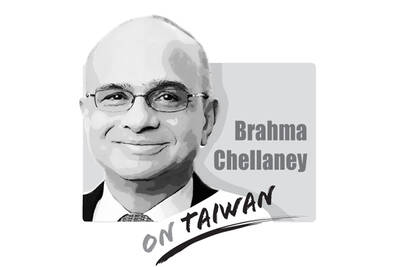On New Year’s Day, Japan’s Noto Peninsula was hit by a magnitude 7.5 earthquake, resulting in heavy casualties. I am a civil engineer and a member of the Tainan Fire Bureau Search and Rescue Team, but I was unable to help with rescue efforts in the disaster zone, as Japan politely declined offers of international rescue assistance.
However, I took a few days off from work to travel to the area and conduct a preliminary survey.
The main disaster causes were soil liquefaction and the collapse of old houses built with woven bamboo and mud walls. This raises the question of whether Taiwan could handle such a seismic disaster.
The areas hit hardest by the earthquake include Wajima, Shushu and Anamizu in the north of the peninsula. My survey focused on Nanao, which lies in the peninsula’s center.
As soon as I arrived, I saw signs of small-scale soil liquefaction along the road, causing protrusions, subsidence and cracks in the road surface. Houses in the disaster area are all three stories or lower in height. Soil liquefaction is affected by a high water table and the distribution of soil composed of different particles. Soil liquefaction only damaged homes in parts of Nanao, mostly in the form of toppled and collapsed old houses with woven bamboo and mud walls — the main cause of casualties.
During Qing Dynasty rule and the Japanese colonial era, many houses in Taiwan were built with woven bamboo and mud walls. The main materials in these homes, some of which still exist, were makino bamboo, mud and rice husks. When the 921 Earthquake hit, many earthen-walled houses collapsed, and although they were not as heavy as brick walls, the weight of fully collapsed roofs and entire houses was still enough to cause death and injury.
How many people in Taiwan still live in such weak and aging homes? This question should be a focal point for the Ministry of the Interior. Furthermore, one key point of the ministry’s earthquake-proofing reinforcement measures should be how to reduce casualties when earthen-walled houses are struck by earthquakes.
In the Noto Peninsula earthquake, heavy snowfall and inconvenient transportation exacerbated secondary disasters. Water stoppages and power outages worsened the situation. The main reason for water supply interruptions is water pipeline ruptures. If a disaster hits an area with emergency backup wells for war preparedness or drought relief, these wells might be an emergency solution, and should be another disaster prevention measure for Taiwan to consider. This would be critical if a disaster zone becomes isolated from outside supplies. As for power outages, they are caused by power line damage. If disaster strikes an area where solar panels have been installed on low-rise building roofs, they could provide some much-needed power.
Search-and-rescue teams should consider more lightweight rescue and relief equipment for deployment to hard-to-reach disaster zones. Any medium-sized search-and-rescue team in Taiwan consists of about 70 people with rescue equipment weighing several tonnes. How could such a team have reached the Noto Peninsula to help with disaster relief? In a scenario where all the collapsed houses are built with woven bamboo and mud walls, a team using lightweight equipment would have a good chance of rescuing many people and reducing casualties.
Let us pray for the Noto Peninsula disaster victims and hope that their lives could soon return to normal.
Johnson Kung is a board member of the Taiwan Professional Civil Engineers’ Association and a member of the Tainan Fire Bureau Search and Rescue Team.
Translated by Julian Clegg

China badly misread Japan. It sought to intimidate Tokyo into silence on Taiwan. Instead, it has achieved the opposite by hardening Japanese resolve. By trying to bludgeon a major power like Japan into accepting its “red lines” — above all on Taiwan — China laid bare the raw coercive logic of compellence now driving its foreign policy toward Asian states. From the Taiwan Strait and the East and South China Seas to the Himalayan frontier, Beijing has increasingly relied on economic warfare, diplomatic intimidation and military pressure to bend neighbors to its will. Confident in its growing power, China appeared to believe
After more than three weeks since the Honduran elections took place, its National Electoral Council finally certified the new president of Honduras. During the campaign, the two leading contenders, Nasry Asfura and Salvador Nasralla, who according to the council were separated by 27,026 votes in the final tally, promised to restore diplomatic ties with Taiwan if elected. Nasralla refused to accept the result and said that he would challenge all the irregularities in court. However, with formal recognition from the US and rapid acknowledgment from key regional governments, including Argentina and Panama, a reversal of the results appears institutionally and politically
Legislators of the opposition parties, consisting of the Chinese Nationalist Party (KMT) and the Taiwan People’s Party (TPP), on Friday moved to initiate impeachment proceedings against President William Lai (賴清德). They accused Lai of undermining the nation’s constitutional order and democracy. For anyone who has been paying attention to the actions of the KMT and the TPP in the legislature since they gained a combined majority in February last year, pushing through constitutionally dubious legislation, defunding the Control Yuan and ensuring that the Constitutional Court is unable to operate properly, such an accusation borders the absurd. That they are basing this
Chinese Nationalist Party (KMT) Chairwoman Cheng Li-wun (鄭麗文) was on Monday last week invited to give a talk to students of Soochow University, but her responses to questions raised by students and lecturers became a controversial incident and sparked public discussion over the following days. The student association of the university’s Department of Political Science, which hosted the event, on Saturday issued a statement urging people to stop “doxxing,” harassing and attacking the students who raised questions at the event, and called for rational discussion of the talk. Criticism should be directed at viewpoints, opinions or policies, not students, they said, adding